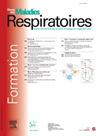Single-cell transcriptomics identify cell-type specific transcriptomic signatures in response to CdCl2 in human airway bronchial epithelial cells cultured at the air-liquid interface
IF 0.5
4区 医学
Q4 RESPIRATORY SYSTEM
引用次数: 0
Abstract
Introduction
The aim of this project is to determine whether single-cell transcriptomics (sc-RNAseq) can provide information susceptible to enrich classical bulk transcriptomics experiments in toxicology. In the present work, we studied the effects of a non-genotoxic carcinogen (CdCl2) on human airway pseudostratified epithelium.
Methods
The identification of cell-type-specific gene expression signatures was performed through scRNA-seq analyses using PARSE technology on human airway bronchial epithelial cells (HAEC) cultured in 3D at an air-liquid interface (ALI) and exposed to 10 μM CdCl2, an heavy metal pollutant present in cigarette smoke. These cell-type specific responses signatures were validated through RNA-Fluorescence In Situ Hybridizations.
Results
Single-cell gene profiling indicated that different regulons are modulated in a cell-type-specific manner in response to CdCl2 exposure. For instance, we showed that treatment with CdCl2 stimulated the expression of MT1G, MT1 M and to a lesser extent SLC30A1 and HMOX1 preferentially in multiciliated and mucus-secreting cells, while AKT3 and IL1RN are rather induced in basal cells. Among the cadmium-regulated genes, we found that the long non-coding RNA LUCAT1 is induced in specific differentiated cell types. We previously showed1 that LUCAT1 is i) upregulated by hypoxia in lung adenocarcinomas, ii) correlated with poor prognosis in patients and iii) involved in the regulation of oxidative stress in cancer cells. However, its cellular sourcing and physiological role in the differentiated mucociliary airway epithelium have not yet been addressed. We found that LUCAT1 is slightly expressed in the untreated epithelium, but in response to hypoxia or CdCl2, it is markedly induced in suprabasal and deuterosomal cells and in differentiated secretory and multiciliated cells but not in basal cells. Using a CRISPR-Cas9-RNP approach2 to knockdown LUCAT1 in basal bronchial stem cells, we will decipher the cell state-specific functions of this gene i) in the regeneration steps of a fully differentiated mucociliary human airway epithelium and, ii) in hypoxia- and CdCl2-responses.
Conclusion
ScRNA-seq reveals distinct transcriptional responses to CdCl2 among airway epithelial cell subtypes. This method could be applied to other molecules to classify gene expression variations and develop predictive tests for non-genotoxic carcinogens compounds. This study also precise the physiological role of LUCAT1 in the homeostasis, regeneration and stress-response of HAEC.
单细胞转录组学鉴定了在气液界面培养的人气道支气管上皮细胞对CdCl2响应的细胞类型特异性转录组特征
本项目的目的是确定单细胞转录组学(sc-RNAseq)是否可以为毒理学中经典的大量转录组学实验提供敏感的信息。在本研究中,我们研究了一种非基因毒性致癌物(CdCl2)对人气道假分层上皮的影响。方法对暴露于10 μM CdCl2(香烟烟雾中的重金属污染物)的人气道支气管上皮细胞(HAEC)在气液界面(ALI)三维培养,采用PARSE技术通过scRNA-seq分析鉴定细胞类型特异性基因表达特征。通过rna荧光原位杂交验证了这些细胞类型特异性反应特征。结果单细胞基因分析表明,CdCl2暴露后,不同的调控机制以细胞类型特异性的方式被调节。例如,我们发现CdCl2刺激MT1G、mt1m的表达,并在较小程度上刺激SLC30A1和HMOX1在多毛细胞和粘液分泌细胞中的表达,而AKT3和IL1RN则在基底细胞中受到诱导。在镉调控基因中,我们发现长链非编码RNA LUCAT1在特定的分化细胞类型中被诱导。我们之前的研究表明,LUCAT1在肺腺癌中因缺氧而上调,ii)与患者预后不良相关,iii)参与癌细胞氧化应激的调节。然而,其细胞来源和在分化的黏毛气道上皮中的生理作用尚未得到解决。我们发现LUCAT1在未处理的上皮中有少量表达,但在缺氧或CdCl2的作用下,LUCAT1在基底上细胞和后染色体细胞以及分化的分泌细胞和多纤毛细胞中被显著诱导,而在基底细胞中不被诱导。使用CRISPR-Cas9-RNP方法2敲除基础支气管干细胞中的LUCAT1,我们将破解该基因的细胞状态特异性功能i)在完全分化的粘膜睫状人气道上皮的再生步骤中,ii)在缺氧和cdcl2反应中。结论scrna -seq揭示了不同类型气道上皮细胞对CdCl2的转录反应。这种方法可以应用于其他分子来分类基因表达变异,并开发非遗传毒性致癌物化合物的预测测试。本研究还明确了LUCAT1在HAEC体内平衡、再生和应激反应中的生理作用。
本文章由计算机程序翻译,如有差异,请以英文原文为准。
求助全文
约1分钟内获得全文
求助全文
来源期刊

Revue des maladies respiratoires
医学-呼吸系统
CiteScore
1.10
自引率
16.70%
发文量
168
审稿时长
4-8 weeks
期刊介绍:
La Revue des Maladies Respiratoires est l''organe officiel d''expression scientifique de la Société de Pneumologie de Langue Française (SPLF). Il s''agit d''un média professionnel francophone, à vocation internationale et accessible ici.
La Revue des Maladies Respiratoires est un outil de formation professionnelle post-universitaire pour l''ensemble de la communauté pneumologique francophone. Elle publie sur son site différentes variétés d''articles scientifiques concernant la Pneumologie :
- Editoriaux,
- Articles originaux,
- Revues générales,
- Articles de synthèses,
- Recommandations d''experts et textes de consensus,
- Séries thématiques,
- Cas cliniques,
- Articles « images et diagnostics »,
- Fiches techniques,
- Lettres à la rédaction.
 求助内容:
求助内容: 应助结果提醒方式:
应助结果提醒方式:


